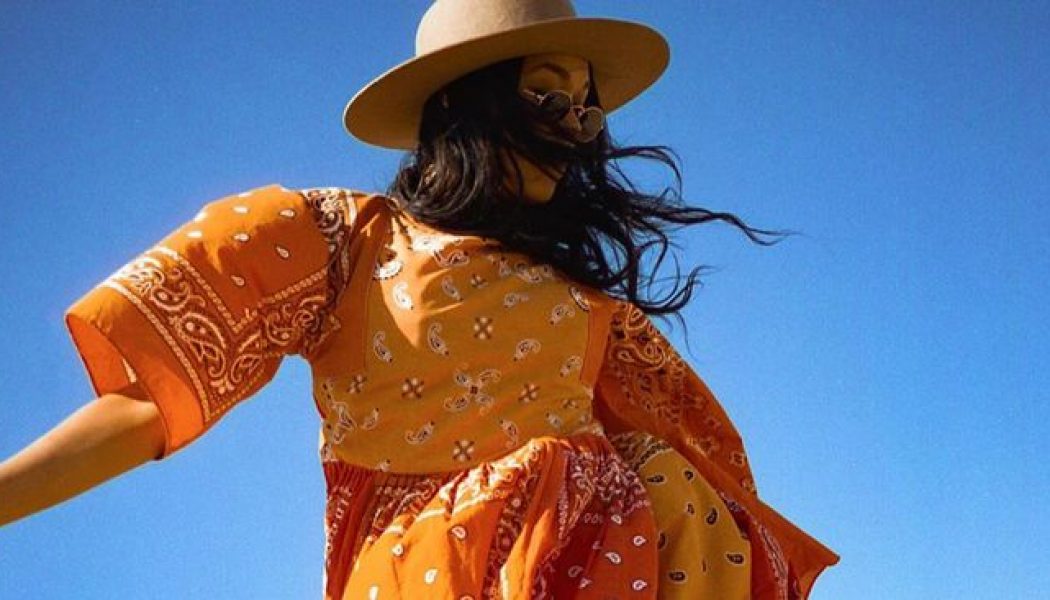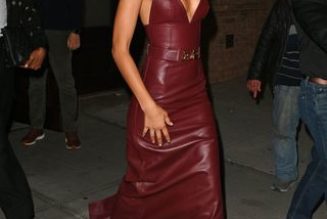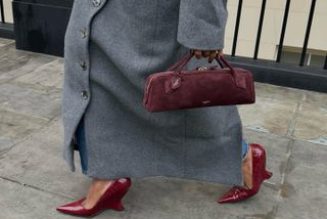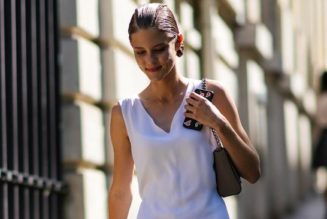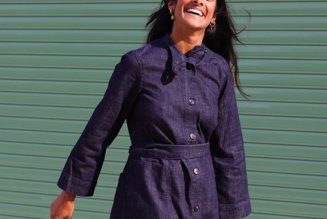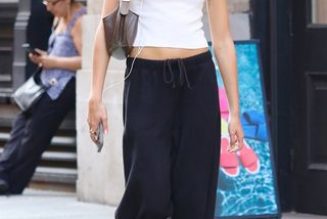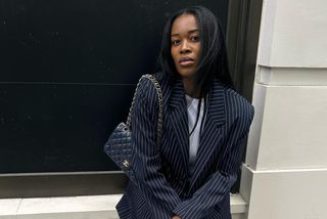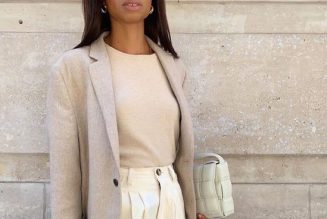
In 2012, when I studied abroad at the University of Texas at Austin, I became somewhat obsessed with shopping secondhand. During the time that I probably should have spent in the library, my friends and I would trawl through the city’s unique thrift stores, tracking down and trying on the best items we could find. Whether it was a 1980s-style Christian Dior purple power suit complete with covered buttons and padded shoulders, or simply a floral cotton dress that looked like it belonged on the set of Dawson’s Creek, we were always elated with our diamond in the rough finds. While I am embarrassed to admit it, at the time my secondhand shopping habit had very little to do with sustainability or the environment and much more to do with budget and perceived cool-factor. Of course, now I know those two elements do not have to be mutually exclusive.
According to Oxfam, every week the UK sends an estimated 13 million items of clothing to landfill. Yearly, that is enough to equate to the weight of the Empire State Building. It’s a sobering fact, to say the least. Luckily, through their own initiatives, Oxfam manages to save many garments from that fate, though there is still more that can be done.
While in the fashion industry, September is traditionally epitomised by runway shows, street style images and the general concept of newness, Oxfam is challenging us to rethink the month through their creation of Secondhand September. The initiative encourages all to consciously only shop secondhand for the entire month (and even beyond).
Of course, frequenting your local charity shop is one way to support this initiative. Though over the years, more and more innovative brands have launched helping to completely revolutionise the way we see the concept of secondhand. From highly-curated, luxurious vintage edits to rental services and brands that manufacture using solely upcycled or discarded fabrics, the idea of secondhand is no longer just about shopping at your local charity shop.
With this in mind, we wanted to highlight a few brands that are helping us to reimagine the world of secondhand, whether it be turning quilts into coats, encouraging peer-to-peer rental as an antidote to fast-fashion or simply offering elevated vintage edits. Keep scrolling to discover 8 brands we love.
Even in my wildest dreams, I couldn’t have thought up the enviably-cool concept behind Psychic Outlaw, the Austin-based brand that upcycles bandanas to create dresses and old quilts to create coats and jackets. “Patchwork has always been something that I have been attracted to wearing because I feel that the randomness of colours and patterns suits my personality,” explained the brand’s founder. “It is also part of my childhood, my Nana is a quilter; she was always making me clothing and blankets.There are so many creative ways to reuse what we already have!”
It’s this exact thought process that makes Psychic Outlaw’s business concept so unique. Where possible, the brand encourages customers to send in their own old bandanas and quilts for use in their custom clothing, resulting in the creation of items that are both uniquely personal and one of a kind. “Even just spreading the idea of making your own clothes and mending what you already own, as a trend, is wonderful to see.”
Did you know there are more jeans in the world than people? In fact, according to Newsweek, five billion pairs are produced annually. It was precisely this realisation that led Anna Foster to create E.L.V. Denim, the contemporary jean brand that manufactures all of its product from upcycled denim, right here in London.
“E.L.V. Demin was born from a desire to create something beautiful from things that are no longer wanted and discarded,” explained the designer, who has instilled a zero-waste ethos in her company. (Even the brand’s leather labels are made from discarded off-cuts). So why does Foster think Secondhand September is so important? “The consumer has the power, and if they make those choices to shop consciously, all businesses that don’t adhere to environmental and social values will have to change to survive– that’s the dream.”
Created in North East England, Dipwood Studio lovingly makes its pieces from vintage linen (some of which still features its original, delicate embroidery) or deadstock fabric. The brand’s founder Abigail Nicholson was originally purchasing new linen but then had a change of heart. “When I started to think about my responsibility to the environment and what I wanted my brand to stand for I started to think about no longer using new fabrics. I wondered could I find vintage linens and started to source these beautiful French antique bed linens,” she explained. “Linen is also really good for dyeing so I will dye indigo, or black or using local plants I have foraged.”
Releasing seasonal collections, which tend to sell out quite quickly, each of Dipwood Studio’s pieces contains its own unique history, which is something the designer aims to honour. “There’s such a history to the pieces I always like to have a moment of respect and thanks to whoever had worked on the production of the linen in the past.”
“I grew up going to car boot sales every weekend with my grandparents and rummaging in charity shops with my mum, so the thrill of finding a vintage treasure has stuck with me,” explained Selena Williams, founder of Selena’s Shop. “Selena’s Shop grew from my love and passion for vintage clothing.”
Personally handpicking each item herself, Selena’s Shop stocks clothing, accessories and even homewares. “You can own a one-off piece of amazing clothing that has already stood the test of time,” the founder said, elaborating on her affinity for vintage. “And by doing this you will also be helping our environment, as the fashion industry is one of the biggest offenders when it comes to pollution.” Featuring carefully curated items shot against beautiful backdrops, Selena is proving that, despite its history, vintage clothing can, in fact, feel entirely modern.
Having spent her teenage years rummaging through thrift stores in Sweden, it was a natural extension for Ameli Lindgren to create her own vintage brand, which is how Nordic Poetry came to be. Specialising in unique, luxury designer finds, Nordic Poetry has become a beloved go-to amongst fashionable Londoners.
“To consume consciously does not mean you have to sacrifice your style,” Ameli says. “Shopping vintage allows you to purchase unique pieces that reflect your personality and help to express your individuality.” In terms of her thoughts on Secondhand September, “in our world, every month is Secondhand September,” Ameli explained.
“I love the idea of wearing something unique and special that has a history. I even wore vintage on my wedding day,” says Helen Emberton, founder of Found & Curated Vintage. “I want to banish the preconceptions that vintage clothing is filled with musty, boring, unwearable, old fashioned pieces and instead get those that are quick to hit the high street to check out a preloved option first.”
Aside from her vintage offering, Helen also creates upcycled garments of her own, sourcing vintage fabric that would otherwise end up in landfill and giving it new life by turning it into handmade blouses, bags or on-trend detachable collars. “Wearing vintage clothing isn’t all about wafting around a meadow in a vintage Laura Ashley dress, instead secondhand September has demonstrated how preloved items can still look fashionable and fit into your existing wardrobe,” she explained. (We couldn’t agree more!)
Conscious of the way the fashion industry was impacting the world, Eshita Kabra-Davies created peer-to-peer fashion rental app By Rotation, with the aim of transforming the way we consume.
“I noted a lack of fashion rental options in the UK and upon further digging, I discovered the extent to which the fashion industry is responsible for pollution and modern slavery. That’s when I decided to take the traditional fashion rental concept a step further by creating a community of regular people who love and share quality fashion with each other,” the founder explained. As a fashion devotee herself, Kabra-Davies wanted to create “a like-minded yet diverse community with which [customers] can confidently experiment with their style, as opposed to turning to fast fashion to satisfy every whim.”
The brand’s slogan #whatsmineisyours perfectly encapsulates this vision, championing the concept that our outfits don’t always need to be new to feel new.
Rent £8 per day | £51 weekly
Rent £24 per day | £96 weekly
Rent £8 per day | £57 weekly
“As a millennial, I’m of a generation that doesn’t question shared ownership,” explained Victoria Prew when asked about the thought process behind founding clothing rental company, Hurr. “I’ve witnessed the rise of disruptive tech-first businesses such as Uber and Airbnb – we rent cars and houses, so why not our wardrobes?”
Enabling customers to wear high-fashion at fast-fashion prices, Hurr’s peer-to-peer rental model provides, “the fast-fashion customer with a smarter way to shop, that’s matched on price but without the environmental impact.” The company has also recently partnered with Selfridges, allowing its customer base to access the latest designer and contemporary collections, without the commitment of making an investment purchase.
Rent £45 – 4 DAYS | Retail £674
Rent £54 – 4 DAYS | Retail £552
Rent £29 – 4 DAYS | Retail £300
Next up, the biggest A/W20 fashion trends you need to know.


